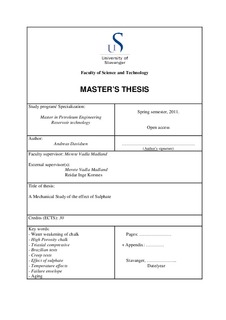| dc.contributor.author | Davidsen, Andreas | |
| dc.date.accessioned | 2011-10-28T10:13:46Z | |
| dc.date.available | 2011-10-28T10:13:46Z | |
| dc.date.issued | 2011 | |
| dc.identifier.uri | http://hdl.handle.net/11250/183327 | |
| dc.description | Master's thesis in Petroleum engineering | no_NO |
| dc.description.abstract | In this study the presence of sulphate in seawater was examined from a mechanical point of view. As test material an outcrop chalk from the Hallembaye area in Belgium called Liegé was used. This is a high porosity outcrop chalk with an average porosity of approximately 40 %. To study the effect sulphate has on chalks mechanical strength synthetic seawater (SSW) and synthetic seawater without sulphate (SSW-(SO42-)) was used as saturation and flooding fluids. Two different test temperatures (ambient temperature and 130 °C) was used to study if reduction in mechanical strength caused by the presence of sulphate in the brine would be dependent on temperature.
Hydrostatic, deviatoric (with varying degree of radial support) and Brazilian tests were conducted such that an estimate of the failure envelopes for the different test parameters (temperature and flooding fluid) could be obtained. By comparing such failure envelopes for one can study how the resistance against shear failure and pore collapse is affected by the presence sulphate and temperature. In total three creep tests at 130 °C were included to study how the resistance against hydrostatic compression were affected by the presence of sulphate in the flooding fluid.
On the basis of the results obtained from the different triaxial tests it was shown that chalk cores tested at 130 °C were weaker against both shear failure and pore collapse in the presence of sulphate. The largest overall reduction in mechanical strength was observed for stress situations where pore collapse was the dominant failure mechanism (deviatoric tests performed with a high degree of radial support). The yield points and Young’s modeli for tests performed without any presence of sulphate in the flooding fluid were a factor 1.3 higher than for the tests performed with sulphate present flooding fluid. A reduction in mechanical strength due to the presence of sulphate was not observed for tests performed at ambient temperature. In fact a somewhat higher resistance against shear failure was observed when sulphate was present in the brine. It was also shown that the weakening caused by sulphate was dependant on the test temperature, while tests performed in the absence of sulphate appeared to be unaffected by temperature. The yield points and Youngs modeli for tests performed at ambient temperature in the presence of sulphate were a factor 1.5 higher than for the tests performed at 130 °C.
Results obtained from the creep tests at 130 °C showed that the axial strain experienced was to a large extent dependant on the sulphate in the flooding fluid. The axial creep strain experienced during synthetic seawater flooding (SSW) was shown to be a factor 1.62 higher compared to the axial creep strain experienced during flooding of synthetic seawater without sulphate (SSW-(SO42-)). It was also shown that introduction of sulphate in the flooding fluid induced a significant increase in compaction. Removing sulphate from the flooding fluid was shown to have the opposite effect were a reduction in deformation rate was observed. Chemical analysis performed on effluent samples collected during creep showed a large reduction in magnesium concentration which was shown to most likely be a result of precipitation of magnesium bearing minerals inside the core. A reduction in sulphate concentration was also observed and which was shown to be dependent on the composition of the prior flooding fluids. | no_NO |
| dc.language.iso | eng | no_NO |
| dc.publisher | University of Stavanger, Norway | no_NO |
| dc.relation.ispartofseries | Masteroppgave/UIS-TN-IPT/2011; | |
| dc.subject | petroleumsteknologi | no_NO |
| dc.subject | reservoarteknologi | no_NO |
| dc.title | A mechanical study of the effect of sulphate | no_NO |
| dc.type | Master thesis | no_NO |
| dc.subject.nsi | VDP::Technology: 500::Rock and petroleum disciplines: 510::Petroleum engineering: 512 | no_NO |
